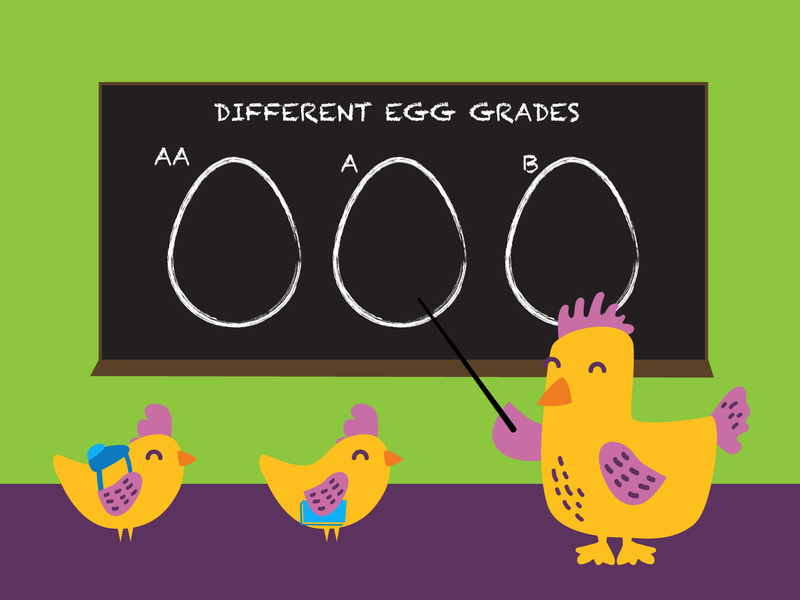
Report card day!
Your memories might include anxiety or pizza parties, or maybe even both, and our eggs totally get how you feel. Did you know that just like students, every egg gets a report card? Well, sort of. If you've ever looked closely at an egg carton, you've probably noticed the words "Grade A" on it. Maybe you even wondered, what are egg grades? What do egg grades mean? What makes an egg Grade A, anyway? And what's the best grade of eggs? Buckle up for a quick lesson and get all the answers to your questions about egg grades. Don't worry, there won't be a pop quiz at the end.
What are egg grades and what do they mean?
While most students have to study hard, take tests, and do their homework to get good grades, quality is what determines an egg's grade. Egg grades are set and monitored by the United States Department of Agriculture (USDA). Currently, there are three categories recognized by the USDA: Grade AA, Grade A, and Grade B. So what determines an egg's grade? It's all about the appearance, condition, and quality of the egg's shell, egg white, and yolk. Contrary to popular belief, egg size is its own category; it isn't factored into egg grading. Here's what each egg grade means and what the USDA looks for when assigning that grade:
Grade AA
Grade AA is the highest grade possible for eggs. Think of this grade as the equivalent of receiving extra credit on your already perfect homework (like getting all those math problems right and showing your work). These eggs have clean, unbroken, strong shells and thick, firm egg whites with only a very small amount of "secondary" egg white, which is the thinner, less viscous liquid that spreads slightly faster than the rest of the egg white when an egg is cracked into a pan. These eggs have round, substantial yolks that stand up tall and proud with few to no defects (such as blood spots). Grade AA eggs are sold in many grocery stores across the country, but aren't quite as ubiquitous as the grade below them and tend to be much pricier.
Grade A
Grade A eggs are the most common option found in grocery stores and supermarkets in the United States. Like Grade AA eggs, they have high, round, yolks free of defects in most cases. Their shells are clean and unbroken. The biggest noticeable difference between these eggs and those of the highest grade is the egg white: Grade A egg whites are strong and substantial, but can be slightly looser in texture than Grade AA egg whites. We'll put it this way: if you cracked a Grade AA egg and a Grade A egg into two pans side by side, you'd probably see the Grade A egg white spread a bit more across the pan than the Grade AA egg white. It's not a huge difference, but it's one of the small factors that the USDA uses to differentiate these top two grades.
Grade B
Due to their lesser quality, Grade B eggs aren't usually sold in grocery stores. These eggs have fairly thin, weak, and watery whites that spread in a thin layer when cracked open. Their yolks tend to be flat rather than round and tall. As for shells, some light staining is permitted, but cracks are not. Grade B eggs don't go to waste, though; they're often sent to manufacturers that make liquid, frozen, and dried egg products.
What grade are Nellie's Free Range Eggs?
All of the eggs from free range farms that go into Nellie's Free Range Egg cartons are Grade A or better. We're often asked why our eggs aren't labeled Grade AA if they're truly the best of the best, and it's a great question! Most fresh eggs from healthy hens like ours actually start out as Grade AA, but as the eggs age over the course of their brief journey from farm to store, the egg whites tend to get looser, thereby lowering the grade of the eggs over time. In reality, many of our fresh, free range eggs may qualify for Grade AA, but we've chosen to label our cartons with Grade A to reflect the general, overall quality of each batch and adhere to the varying requirements across the many states that our eggs are sold in.
How does Nellie's grade their eggs?
Wondering why you don't see the USDA grade shield on our cartons? Fun fact: egg companies actually aren't required to have their eggs graded by the USDA, and can instead elect to do it themselves. At Nellie's, we check the quality of every single egg before it's packaged into our purple cartons. In addition, it's standard practice for the USDA to perform random inspections of our facilities and eggs on store shelves to confirm that our grading is accurate.









